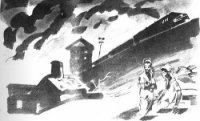Operation Nemesis: The Assassination Plot that Avenged the Armenian Genocide - Bogosian Eric (мир книг .txt) 📗
CHAPTER EIGHT The Big Picture
THEY SIMPLY HAD TO LET HIM GO!
—New York Times headline
It was now time to tell the world about the destruction of the Armenians living in the Ottoman Empire. A series of witnesses was called to the stand to fill in the big picture. An Armenian survivor, Christine Terzibashian, testified about her own, very real ordeal. It would prove to be consistent with reports from missionaries and other observers.
TERZIBASHIAN: When we had left the city and stood before the Erzurum fortress, the gendarmes came and searched for weapons. Knives, shields, and so on were taken away from us. From Erzurum we went to Bayburt. As we passed by this city we saw piles of corpses, and I had to step over corpses so my feet were stained with blood.
LEHMBERG: Were the corpses from earlier groups that had come from Erzurum?
TERZIBASHIAN: No, these were from Bayburt. Then we arrived in Erzincan. We had been promised shelter, but we were not allowed to live there, and we were also not allowed to drink water. We even had to give up our oxen; these were driven into the mountains.
LEHMBERG: Now, what led up to the massacre in which your relatives perished?
TERZIBASHIAN: When we marched on, five hundred young people were selected from the groups. Including one of my brothers. But he managed to escape and join me. I dressed him as a girl so he could stay with me. The other young people were herded together.
LEHMBERG: What happened with those who had been selected?
TERZIBASHIAN: They were all tied together and thrown in the water.
LEHMBERG: How do you know this?
TERZIBASHIAN: I saw it with my own eyes.
LEHMBERG: That they were thrown in the river?
TERZIBASHIAN: Yes, they were thrown in the river, and the current was so strong that all those thrown in the water were carried away.
LEHMBERG: What happened with those remaining?
TERZIBASHIAN: We screamed and cried and did not know what to do. But we were not even allowed to cry but were driven forward by stabbing.
LEHMBERG: Who did that?
TERZIBASHIAN: Thirty soldiers, and a detachment of soldiers.
LEHMBERG: Were they beating you?
TERZIBASHIAN: Yes.
LEHMBERG: What happened next with your relatives?
TERZIBASHIAN: We arrived in Malatya with those we could carry on our backs. There we were taken to the mountain and the men were separated from the women. The women were now around ten meters away from the men and could see with their own eyes what happened to the men.
LEHMBERG: What happened with the men?
TERZIBASHIAN: They were murdered with axes and tossed from the land into the water.
LEHMBERG: Were the women and men really massacred in this way?
TERZIBASHIAN: Only the men were murdered in this way. When it was a little dark, the gendarmes came and sought out the most beautiful women and girls and took them for themselves as wives. A gendarme also came over to me and wanted to make me his wife. Those who did not wish to obey, who did not wish to give in, were pierced with bayonets and their legs torn apart. Even pregnant women had their ribs cut through and the children taken out and thrown away.
According to the transcript there was an “uproar in the courtroom” as Terzibashian raised her hand and said, “I swear to this.” Lehmberg responded, “And is all of this really true: Is this not fantasy?” Her reply triggered another wave of commotion: “What I’ve told is still far less than the reality. It was much worse.”
Terzibashian was followed by three “star witnesses”: Dr. Johannes Lepsius, a revered humanitarian who had published books on the massacres of the 1890s; General Otto Limon von Sanders, the highest-ranking German military official in Turkey during the war;1 and Krikoris Balakian, a refugee Armenian bishop who had traveled from Manchester, England, to testify. All three men had known Talat personally, and all three were comfortable in the spotlight.
Lepsius was the greatest Western expert on Armenian culture, history, and, specifically, the Hamidian massacres of twenty-five years earlier. In his reports, essays, and books, Lepsius had made every effort to call the world’s attention to the plight of the Armenians in Asia Minor. Like England’s William Gladstone, who had been prime minister in the 1880s, Lepsius believed that the Turkish government was a unique criminal enterprise that should be suppressed or removed altogether.
In the spring of 1915, when Lepsius learned what was happening to his Armenian friends in Anatolia, he did what he could to publicize the deportations. The German government quickly stepped in and warned the venerable scholar that as a German citizen, he was barred from disparaging the nation’s wartime allies, the Ottoman Turks. For the duration of the conflict, Lepsius remained silent. Now the war was over, and the disgraced Kaiser’s government was no longer in power. The Tehlirian trial gave Lepsius an opportunity finally to have his say.
For an Armenophile like Lepsius, making a clear case regarding the deportations and mass killings was not only about exposing what had happened. It was also an attempt to assist in establishing an independent Armenian nation. Yet even as he charged the Turks with destroying the Armenians, Lepsius whitewashed German complicity. In his testimony he was careful to edit himself and suggest by omission that Germany had had no control over the killings:
Approximately one million four hundred thousand Armenians were deported.
What did this deportation mean? In a decree signed by Talat, we find the statement, “The goal of the deportation is nothingness.” In line with this order, it was seen to that from the entire population transported southwards from the eastern Anatolian provinces, only around ten percent arrived at the deportation’s goal; the remaining ninety percent were murdered in transit or, to the extent that women and girls were not sold by the gendarmes and abducted by Turks and Kurds, killed by hunger and exhaustion. The Armenians were transported to the edge of the desert from western Anatolia, Cilicia, and northern Syria, so that gradually a substantial mass of human beings—in total several hundred thousand—were brought together in concentration camps; they were largely exterminated through systematic starvation and periodic massacres. Namely, as new trains filled up the concentration camps and there was no place left for the mass of people, they were brought to the desert in groups and slaughtered there. Turks have explained that the idea of the concentration camps came from the example of the English with the Boers in South Africa. What is officially declared is that the deportations involved preventive measures; but privately, authoritative persons have indicated with complete openness that the goal was to exterminate the Armenian people.
Lepsius scored points against British brutality as he described the Turkish use of deportations to destroy a population: “Until the present, the Armenians have only been a means to an end in the diplomatic game between England, Russia, and France. As the publication of the German documents will show, Germany has always taken a benevolent and understanding approach in the Armenian question since the Berlin Congress, and in response has been blackened by the entire world as that power behind which all wicked deeds of the sultan and the Turkish government stand.”2




